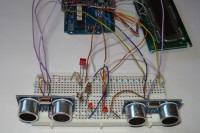Easy Parking System [170080]

Easy-to-build project to assist you when parking your car into a small space.
Easy Parking System (EPS)
The actual parking places in the building are narrow, and year after year, the cars are wider. It’s difficult to park the car without scratching the paint on each side of the car.
That’s why I develop this system with Arduino. The EPS will help you to park your car in such a parking place, with simple light indication.
The context :
Generally, the parking places in the buildings are not supplied by electricity; care must be taken about the power consumption. The EPS will be supplied by USB battery packs to reload regularly; the USB battery packs are here very useful. The battery level is monitored by a Batt-LED on the main box.
The principle:
The principle is to help the driver to park his car in the garage.
The system is made up of 3 boxes:
The two ultra-sonic sensors (one at each side of your garage) measure the distance between the wall and the side of the car. When the measure is too low (< 5 centimetres for example), the relevant light lit on the main box.
The energy saving system:
As said above, this circuit must save energy, because it is supplied by a battery. The way for that is to set the EPS (including the ultra-sonic sensors) in low-power mode when not in use. The EPS turns on by lighting your car lights for a short time: the sensors are activated during a while (some minutes for example), and then the EPS turns in back in sleep mode. So energy is saved when not in use.
Another question is the supply: as said, the USB battery packs can be used: they are easy to reload, to transport, and to connect (. . . and easy to rob if you let the garage door opened . . .). The EPS consumption is lowered as possible: depending on the battery capacity, reload will be necessary about 1 time per month. When the battery level is too low, the Batt-LED will lit on the main box.
If the EPS is installed in your garage near your home, it may be supplied by a 5 volts wall supply. Nevertheless, the energy saving system will work.
The software was developed with Arduino.
The actual parking places in the building are narrow, and year after year, the cars are wider. It’s difficult to park the car without scratching the paint on each side of the car.
That’s why I develop this system with Arduino. The EPS will help you to park your car in such a parking place, with simple light indication.
The context :
Generally, the parking places in the buildings are not supplied by electricity; care must be taken about the power consumption. The EPS will be supplied by USB battery packs to reload regularly; the USB battery packs are here very useful. The battery level is monitored by a Batt-LED on the main box.
The principle:
The principle is to help the driver to park his car in the garage.
The system is made up of 3 boxes:
- The main box contains the microprocessors, the battery (the USB battery packs) for supply, the left and right alarm lights, and the battery level light. This main box will be installed in the back wall of the parking, so the driver can see the left and the right alarm LEDs as the car enters in the parking. When a light lit, the driver must drive very carefully.
- Two boxes contain each 1 ultra-sonic sensor which measure the distance between the left/right wall and the left/right side of the car.
The two ultra-sonic sensors (one at each side of your garage) measure the distance between the wall and the side of the car. When the measure is too low (< 5 centimetres for example), the relevant light lit on the main box.
The energy saving system:
As said above, this circuit must save energy, because it is supplied by a battery. The way for that is to set the EPS (including the ultra-sonic sensors) in low-power mode when not in use. The EPS turns on by lighting your car lights for a short time: the sensors are activated during a while (some minutes for example), and then the EPS turns in back in sleep mode. So energy is saved when not in use.
Another question is the supply: as said, the USB battery packs can be used: they are easy to reload, to transport, and to connect (. . . and easy to rob if you let the garage door opened . . .). The EPS consumption is lowered as possible: depending on the battery capacity, reload will be necessary about 1 time per month. When the battery level is too low, the Batt-LED will lit on the main box.
If the EPS is installed in your garage near your home, it may be supplied by a 5 volts wall supply. Nevertheless, the energy saving system will work.
The software was developed with Arduino.









Updates van de auteur
TechDoc 7 jaar geleden
R1 : 10k
R2 : 220K
R3, R4 : 110R
R5 :
R6 : 1M
R7 : 270k
R8 : 220R
LDR : A 9060 13
C1, C4 : 100nF
C2 , C3 : 22pF
C5 : 10nF
C6 : 100uF
U1 : ATMega328 programmed
X1 : Quartz 16 MHz
IC1 : 78L05 (optionnal, see text)
LED1, 3, 4, 5 : diameter 5 mm, 10500 RT, ultra-bright
LED2 : 119EGW, 2 colours (Red/Green)
D2 : 1N4148
S1, 2, 3 : NAMAE JTP1236 microswitches (or other)
ISP1 : HE6 (optional, used for ISP programming)
H1 : 6 points connector (optional, used for the USB/serial)
US sensors 1, 2 : HC-SR05
PCB terminal blocs1, 2, 3, 4 : RND 205-00014
Cables x 2 : LIYCY 04-10 (10 meters each)
US Sensor casings x 2 : G026 from KEMO-Electronic
Main casing : TEKO P/3.9 (160 x 95 x 61 mm)
1 Battery holder for 4 AA battery
Various plastic pieces to build the battery casing location, red transparent plastic pieces, . .
TechDoc 7 jaar geleden
I hope you all will be satified.